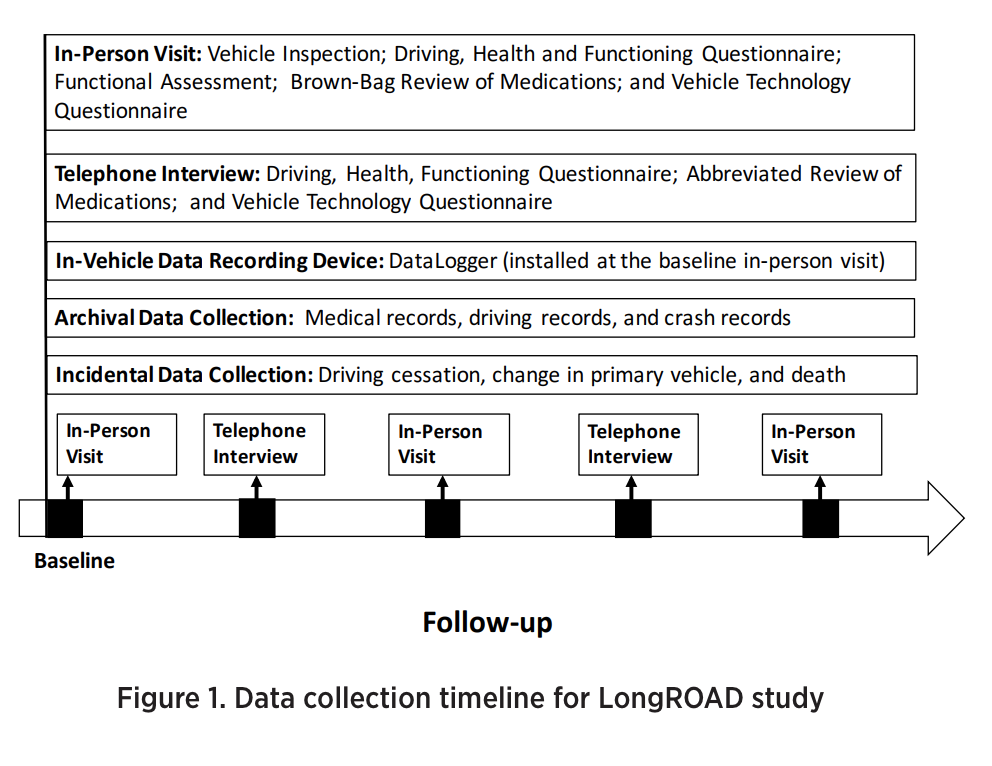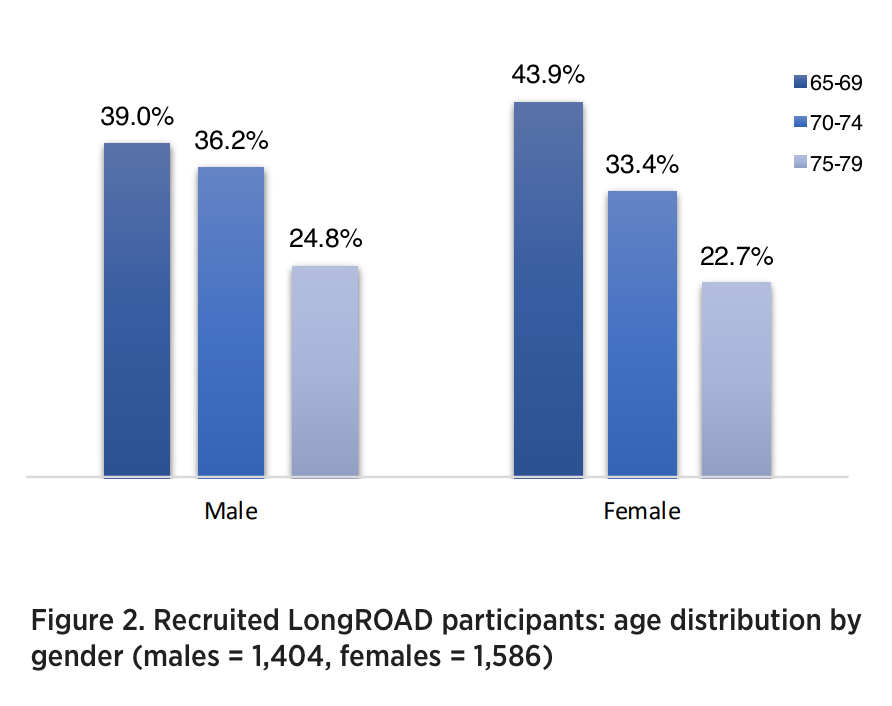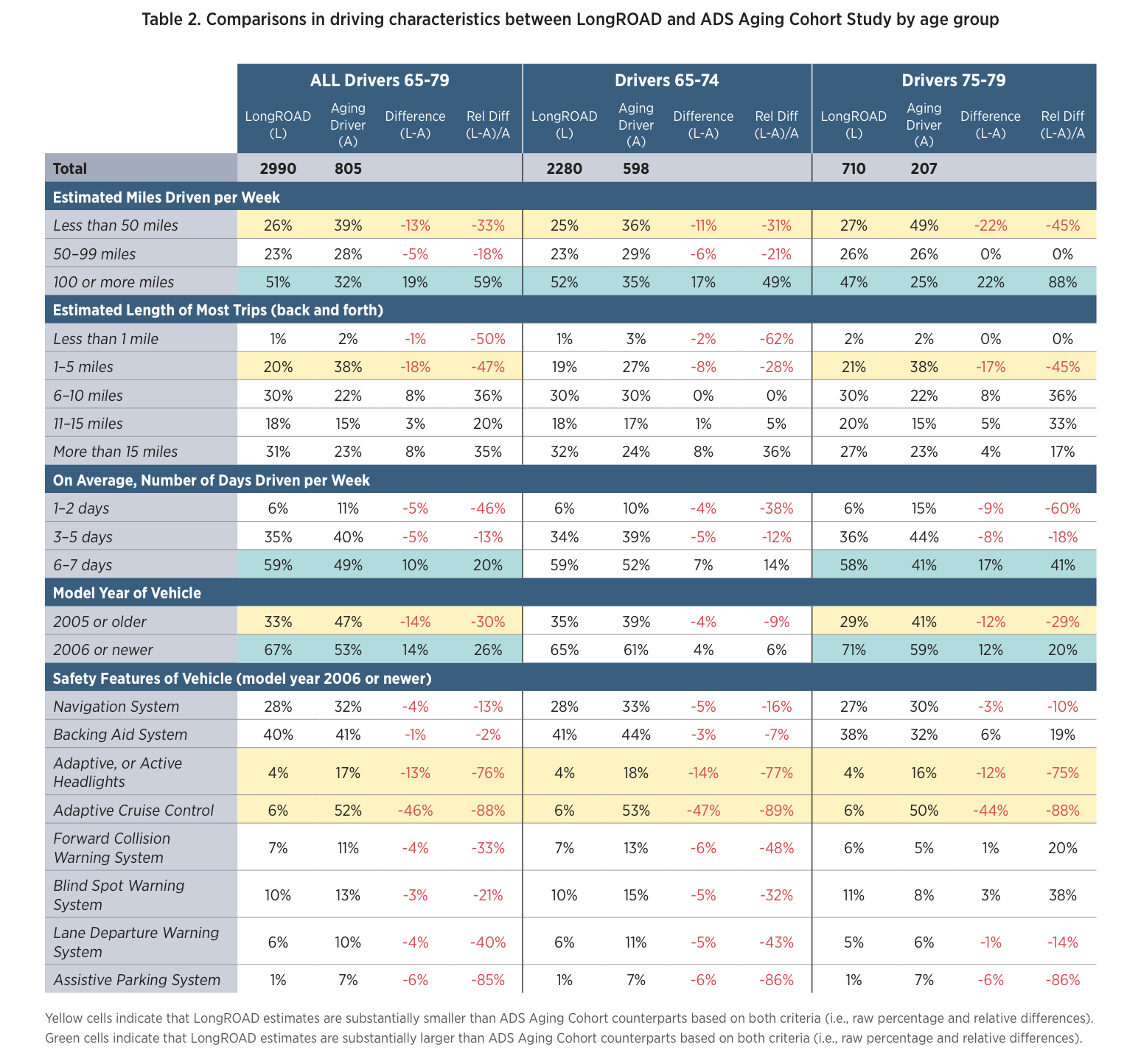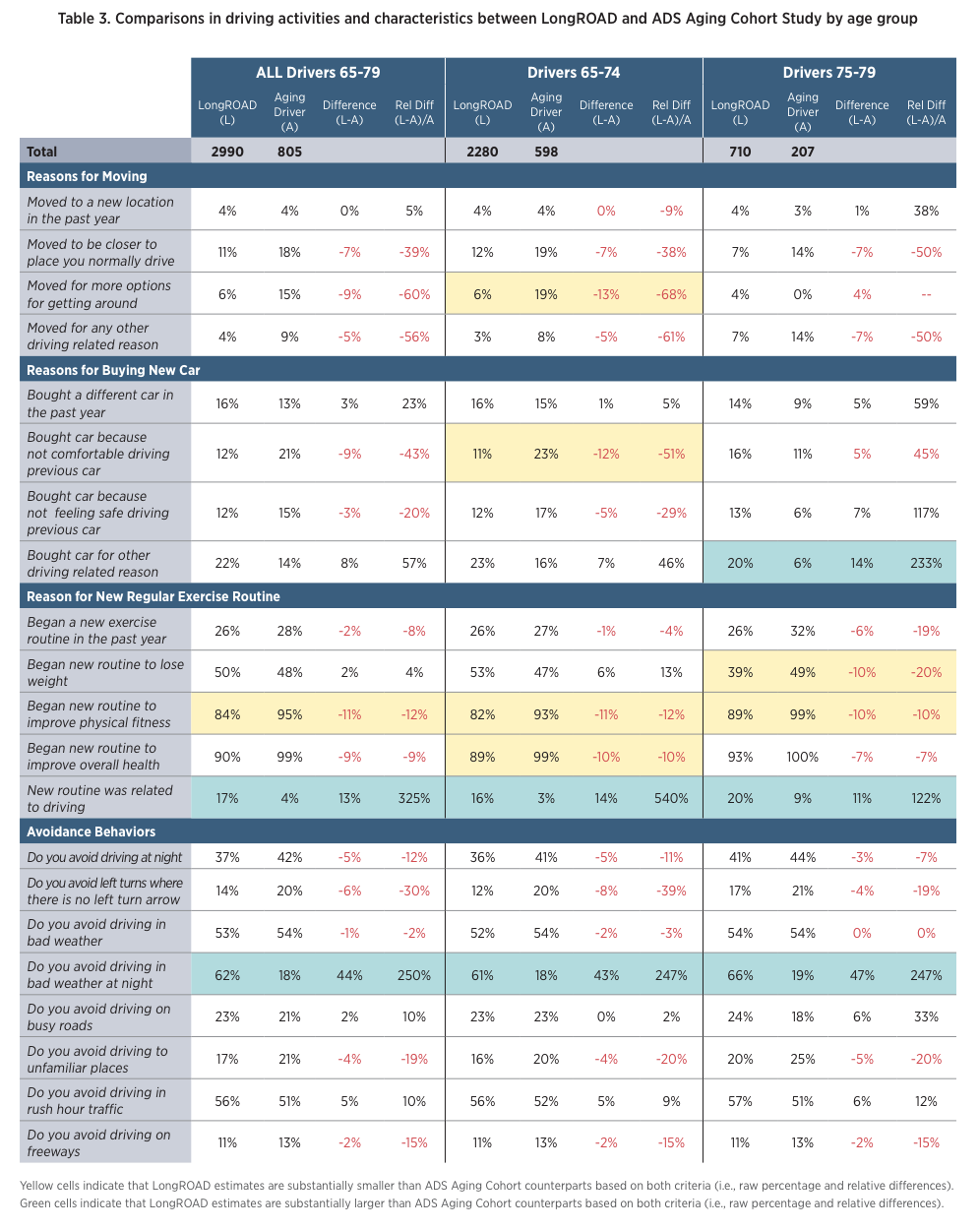
The Longitudinal Research on Aging Drivers (LongROAD) Study: Understanding the Design and Methods
This Research Brief describes the overall design and methods of the Longitudinal Research on Aging Drivers (LongROAD) study--a large-scale prospective cohort study of drivers ages 65+, and succinctly presents the numerous kinds of information being collected from participants.
November 2017
Suggested Citation
For media inquiries, contact:
Tamra Johnson
202-942-2079
TRJohnson@national.aaa.com
Abstract
The LongROAD Study: Methods and Participant Characteristics Research Brief provides a description of the study’s research design methods as well as succinctly presents the numerous kinds of information being collected from participants (via interviews, questionnaires, screening assessments, and the vehicle installed data logger). Additionally, comparisons are made between the LongROAD participants, who were recruited from a health clinic, to participants in a senior driving cohort from the American Driver Survey.
In 2015, 40 million licensed drivers age 65 years and older represented 18% of the total licensed driver population in the United States (FHWA, 2016). The number of older drivers has increased by 50% since 1999 and is projected to continue increasing (FHWA, 2014). Although driving allows older adults to meet their mobility needs and to stay independent, a number of age-related functional impairments, medical conditions and medication side effects can compromise driving abilities (Eby et al., 2009). To understand and meet the safe mobility needs of older adult drivers, the AAA Foundation for Traffic Safety (AAAFTS) launched the Longitudinal Research on Aging Drivers study (LongROAD) with the following goals:
- Better understand the major protective and risk factors of safe driving in older adults
- Assess the effects of medical conditions and medications on driving behavior and safety
- Investigate the mechanisms through which older adults self-regulate their driving behaviors to cope with functional declines as they age
- Determine the extent, use and effects of new vehicle technology and aftermarket vehicle adaptations among older drivers
- Identify the determinants and health consequences of driving cessation during the process of aging
Methods
The LongROAD study is a multisite prospective cohort study designed to collect data on the medical, behavioral, environmental and vehicle technological factors influencing older adults’ driving. Active older drivers ages 65 to 79 years were identified by screening electronic medical records of health systems or primary care clinics affiliated with the five study sites (Cooperstown, New York; Baltimore, Maryland; Denver, Colorado; San Diego, California; and Ann Arbor, Michigan). Study sites mailed recruitment letters to all potentially eligible participants identified through the screening process and then contacted them by telephone. Each site aimed to enroll 600 participants distributed across three age groups (65- 69, 70-74 and 75-79) and between sexes.
Design: What was the study’s strategy for addressing the project’s aims?
The project was designed for an initial five-year period. Eligible and consented participants were assessed at the baseline interview and then annually thereafter (Figure 1). Starting with the baseline visit and continuing every other year during the follow-up, participants are required to complete an in-person visit at the study site. In alternate years, beginning with the first year following the baseline visit, participants receive an abbreviated telephone interview.
Study Measures: What kind of information is being collected?
In-Person Visit and Telephone Follow-Up Interviews
In-person visits last approximately three hours and include several questionnaire administrations, a number of functional assessments, review of medications and a vehicle inspection. Telephone interviews last about one hour and only include questionnaire administration.
Vehicle inspection. A vehicle inspection was conducted on each participant’s vehicle at baseline and is repeated every other year or when the participant changes his or her primary vehicle. The vehicle inspection collects data on the condition and maintenance of the vehicle and the presence of in-vehicle technologies and aftermarket adaptations. Driving, health and functioning questionnaire. At baseline, and annually during in-person and telephone interviews, research staff administer a questionnaire to obtain data on participants’ driving, health and functioning. Specific data from these questionnaires include: demographics; cognitive, mental and physical health; driving behaviors; health behaviors; healthcare utilization and health conditions.
Functional assessment. Functional assessments measure participants’ cognitive, motor, and perceptual levels of functioning. These batteries of measurement were selected based on sound psychometrics properties and their use in other driving/older adult longitudinal studies (e.g., the Health and Retirement Study, the National Health and Aging Trends Study and the Women’s Health and Aging Study) to facilitate comparisons. Each participant was assessed in person at baseline and is assessed every other year thereafter.
“Brown-bag review” of medications. Data on medications and supplements currently taken by each study participant are collected using a “brown-bag review” method at the in-person assessment and annually thereafter. While scheduling the in-person assessment, research staff ask participants to bring all current medications (both prescribed and over the counter) and supplements with them for review.
Vehicle technology questionnaire. To assess the experiences participants have had with advanced vehicle technologies and aftermarket vehicle adaptations in their own vehicles, the vehicle technology questionnaire was administered to participants at baseline and is repeated annually when there has been a change in primary vehicle or when a new aftermarket adaptation or modification has been made. For 15 in-vehicle technologies (listed in Table 1), the questionnaire addresses presence, use and perceptions of safety where appropriate.
The questionnaire also addresses the presence of aftermarket vehicle adaptations. The questionnaire explores the presence of various possible vehicle adaptations listed in Table 1. For each adaptation, the questionnaire asks with whom the participant worked to determine that the adaptation was appropriate, whether a professional made the adaptation, and how the participant learned to use the adaptation.
Table 1. List of in-vehicle technologies and in-vehicle adaptations asked on the Vehicle Technology Questionnaire
| In-Vehicle Technology | In-Vehicle Adaptations |
| Navigation assistance | Cushions for comfort |
| Backup assist/aid | Custom armrests |
| High intensity discharge headlights | Safety belt extensions |
| Directional control headlights | Driver side airbag deactivation |
| Adaptive cruise control | Upper body support |
| Night vision enhancement | Steering knob |
| Forward collision warning | Spin pin |
| Blind spot warning | Palm grip |
| Lane departure warning | Tri-pin |
| Rearview camera | Steering splint |
| Drowsy driver alert | Amputee ring |
| Electronic stability control | Left foot throttle |
| Assistive parking | Gas pedal block |
| Voice control | Pedal extensions |
| Integrated Bluetooth cellular phone | Hand controls |
| Automatic emergency response | Adapted dashboard controls |
| In-vehicle concierge | Aftermarket push button ignition |
| Convex/multifaceted mirrors |
In-vehicle Data Recording Device
At the baseline in-person visit, the participant’s primary vehicle was equipped with an in-vehicle data recording device (called the DataLogger). This device collects objective driving behavior data, including: days driving, trips, miles, miles and minutes per trip, trip chains, miles and minutes per chain, number and percentage of trips at night and day (including peak hours of 7-9 a.m. and 4-6 p.m.), number and percentage of trips on high-speed roads, number and percentage of trips made less than 15 miles from home and over 25 miles from home, number of left and right turns, right to left turn ratio and number of high deceleration and speeding events.
Archival and Incidental Data
Medical records. At baseline, research staff reviewed the medical record of each participant for up to five years prior to the baseline assessment date. During follow-up, the medical record for the previous 12 months is reviewed annually. Data collected from each participant’s medical record include clinical diagnoses, surgical procedures and healthcare utilization in the previous year, including the numbers of hospital admissions and visits to primary care providers, specialists and emergency departments affiliated with the health system.
Driving records. At baseline, up to the previous five years of driving record data were collected. During follow-up, driving record data are collected annually for the previous 12 months. Driving record data collected include driver license status, administrative actions, convicted moving violations and driving-related criminal offenses.
Crash records. Crash data are based on police reports and generally cover all crashes involving injury or death of any person or property damage in excess of $1,000. Driving records indicate the occurrence of crashes, as well as driving-related convictions. At baseline, crash data were collected for up to the past five years. During follow-up, crash data are collected annually for the previous year. In addition to demographic and study information, crash-, vehicle- and person-level data are collected for each crash.
Driving cessation questionnaire and mortality data. It is anticipated that during follow-up, some participants will cease driving permanently. Therefore, a driving cessation questionnaire was designed to collect information about the general circumstances surrounding the decision to stop driving, specific reasons for stopping driving, means of meeting mobility needs following driving cessation and psychosocial factors associated with no longer driving. The questionnaire is administered by telephone one to three months after a participant has permanently stopped driving.
During the follow-up period, it is anticipated that some participants will die. In these cases, data are collected, where possible, about the date and cause of death. These data are acquired through examination of the medical record, discussion with family members and/or review of the death certificate.
Results
Participants: Who is participating in the study?
Recruitment and enrollment were completed between July 2015 and March 2017. A total of 2,990 participants were enrolled in the LongROAD study. Of those recruited, 53% were female. Of all the participants, 41.6% were aged 65-69, 34.7% aged 70-74 and 23.7% aged 75-79 (see Figure 2).
To date (Oct. 19, 2017), first-year anniversary telephone interviews have been completed with 77% (2,317) of the participants, and second-year anniversary in-person visits have been conducted with 305 participants.
LongROAD Participants Compared with General Older Drivers: Do the LongROAD participants resemble older drivers on U.S. roads?
The baseline data from the LongROAD study has been compared with the data from the American Driving Survey (ADS) Aging Cohort Study (Triplett, 2016) to evaluate the similarities of LongROAD participants to a nationally representative sample of drivers. The similarities on two data sets were assessed based on raw percentage differences (i.e., LongROAD – Aging) as well as relative differences (i.e., (LongROAD – Aging)/Aging) through driving characteristics and behaviors. Table 2 shows results on driving characteristics summarizing that LongROAD participants drove more miles, drove more often and took longer trips than did older drivers from the Aging Cohort Study. In addition, a larger proportion of LongROAD participants had 2006 or newer model year vehicles. Interestingly, a smaller proportion of LongROAD participants reported having vehicle safety features present in their vehicles than those of the Aging Cohort Study. However, the estimates on the Aging Cohort Study are highly likely to be over-reported given that vehicle safety features listed in Table 1 are usually present in high-end vehicles.
Table 3 presents comparisons on driving behaviors summarizing that there were no significant discrepancies found between LongROAD and Aging Cohort Study participants in most activities and avoidance behaviors. The only exception is responses to the question, “Do you avoid driving in bad weather at night?” where 62% of LongROAD participants admitted this behavior, whereas only 18% of participants in the Aging Cohort Study reported this. The overall results from these comparisons conclude that avoidance behaviors were similar across two studies, and differences, if any, could be caused by different survey methods (i.e., in-person vs. phone interview).
Discussion
The LongROAD study is the first multisite longitudinal cohort study in the United States that delves into the dynamic changes in driving safety as drivers become older. LongROAD participants were sampled from university-affiliated medical centers; therefore, the data does not necessarily represent the nation’s older drivers in terms of demographic characteristics. LongROAD participants tend to have higher education, income and overall better health. However, comparing LongROAD participants with the ADS Aging Cohort (nationally representative sample of older drivers) shows the two samples are similar with respect to driving behaviors and attitudes.
By collecting multiple sources of information—including GPS information, vehicle information, medication use, functional assessments and archival and incidental data such as medical records, driving records and crash records— this study can explore in great detail the risk factors and changes that happen over time in older adults with regard to driving behaviors, patterns and safety. Furthermore, we anticipate that outcomes from the study can contribute to finding efficient and effective ways to prolong mobility, independence and well-being of older adults.
References
Federal Highwazy Administration, Department of Transportation (US). Highway Statistics 2015. Washington (DC): FHWA; September 2016. [cited 2016 Dec 21]. Available from URL: https://www.fhwa.dot.gov/ policyinformation/statistics/2015/dl20.cfm
Federal Highway Administration, Department of Transportation (US). Highway Statistics 1999. Washington (DC): FHWA; November 2014. [cited 2017 Nov 8]. Available from URL: https://www.fhwa.dot.gov/ policyinformation/statistics/1999/dl20.cfm
Eby, D.W., Molnar, L.J., Kartje, P.S. Maintaining Safe Mobility in an Aging Society. Boca Raton, FL: CRC Press; 2009.
Triplett, T., Santos, R., Rosenbloom, S., & Tefft, B. (2016). American Driving Survey: 2014–2015.
Suggested Citation
For media inquiries, contact:
Tamra Johnson
202-942-2079
TRJohnson@national.aaa.com



